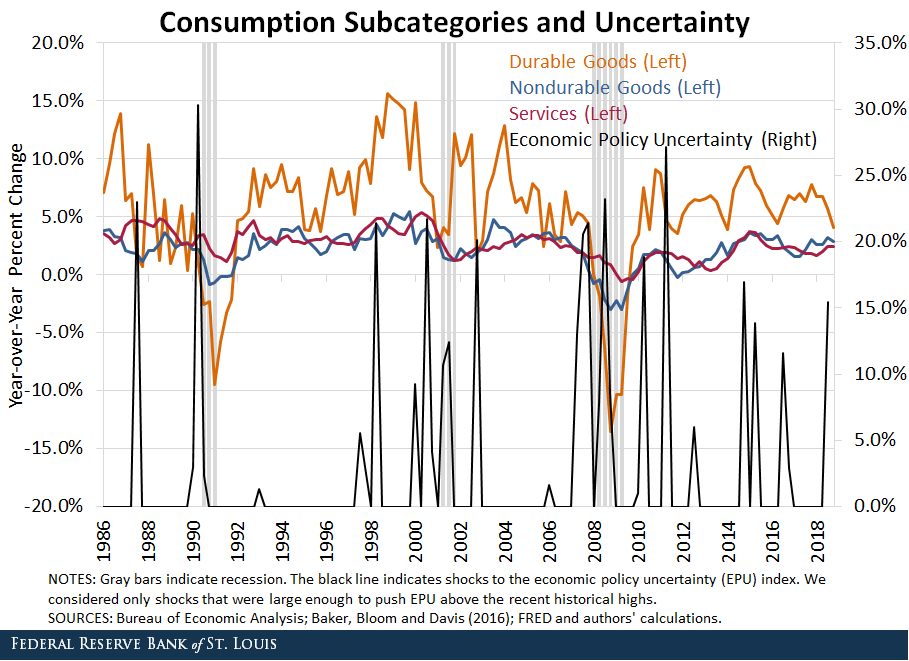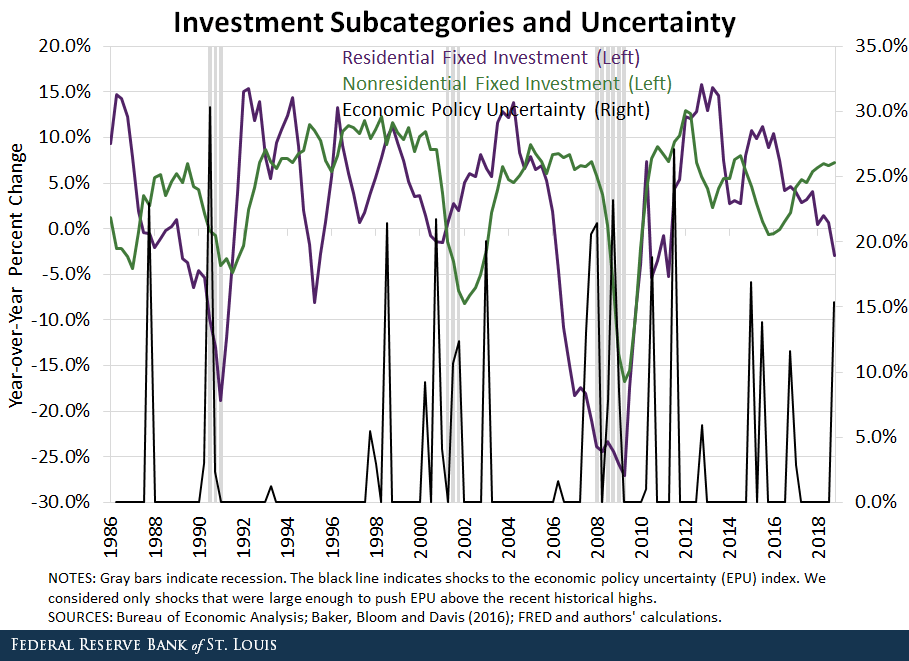Does the Macroeconomy Float in Choppy Waters?

In a recent Economic Synopses essay, we discussed how large changes in economic policy uncertainty (EPU) can affect key macroeconomic indicators like GDP and inflation. Jackson, Laura E.; Kliesen, Kevin L.; and Owyang, Michael T. “A Bad Moon Rising? Uncertainty Shocks and Economic Outcomes.” Federal Reserve Bank of St. Louis Economic Synopses, No. 6, March 1, 2019.
In that analysis, we considered only shocks that were large enough to push EPU above the recent historical highs. EPU is measured by an index that is constructed from the frequency of newspaper articles containing several key search terms. For details on the construction of the index, see Baker, Scott R.; Bloom, Nicholas; and Davis, Steven J. "Measuring Economic Policy Uncertainty." Quarterly Journal of Economics, November 2016, Vol. 131, Issue 4, pp. 1593-636. Thus, changes in the EPU do not necessarily have proportional changes on the economy.It is relatively uncontroversial that uncertainty shocks are contractionary: An increase in uncertainty, however measured, generally results in a decrease in output. Here, we consider how uncertainty transmits to the macroeconomy by examining its effects on some of the disaggregate components of GDP.
Breaking Down GDP Components
Two of the major components of GDP—consumption and investment—can be broken down into three subcategories each. Consumption is comprised of:
- Durables
- Nondurables
- Services
Investment is comprised of:
- Residential fixed investment
- Business fixed investment
- Inventories
Consumption
The consumption variables are displayed in the figure below.

Of the three consumption variables, durables consumption falls the most following a large increase in uncertainty; services consumption contracts the least. After eight quarters, all three consumption categories begin to recover but durables consumption's recovery is the sharpest. These results support the view that households exercise precautionary reductions in spending when uncertainty spikes. When the economy experiences a high uncertainty episode, households curb all spending—in particular, durables spending. The decline in durables, however, is an intertemporal substitution—households essentially defer the large durables purchases until later when the state of the economy is clearer.
Investment
The investment variables are displayed in the figure below.

In the wake of a large increase in uncertainty, we find that residential investment falls more on impact and declines more sharply than the other two investment series, but it also rebounds more quickly. Similar to delaying large durables purchases, households defer homebuilding and home improvements until the state of the economy is clearer.
Businesses behave similarly. However, business fixed investment falls for a longer duration after the shock and exhibits a more persistent contraction. The decline in inventories is small but persistent and occurs even as consumers reduce spending. This suggests that businesses might be cutting back on both investment and production.
The persistence of the decline in business fixed investment may reflect the long-term planning required for capital investment. Businesses often plan investment several years in advance and, thus, cannot adjust intertemporally on the fly as easily as households.
Notes and References
1Jackson, Laura E.; Kliesen, Kevin L.; and Owyang, Michael T. “A Bad Moon Rising? Uncertainty Shocks and Economic Outcomes.” Federal Reserve Bank of St. Louis Economic Synopses, No. 6, March 1, 2019.
2 EPU is measured by an index that is constructed from the frequency of newspaper articles containing several key search terms. For details on the construction of the index, see Baker, Scott R.; Bloom, Nicholas; and Davis, Steven J. "Measuring Economic Policy Uncertainty." Quarterly Journal of Economics, November 2016, Vol. 131, Issue 4, pp. 1593-636.
Additional Resources
- Economic Synopses: A Bad Moon Rising? Uncertainty Shocks and Economic Outcomes
- On the Economy: Is the U.S. Economic Expansion Due to End?
- On the Economy: What’s Behind the Global Decline in Trade Barriers?
Related Topics
This blog offers commentary, analysis and data from our economists and experts. Views expressed are not necessarily those of the St. Louis Fed or Federal Reserve System.
Email Us
All other blog-related questions


